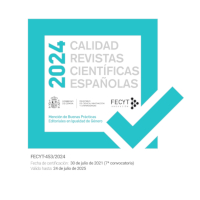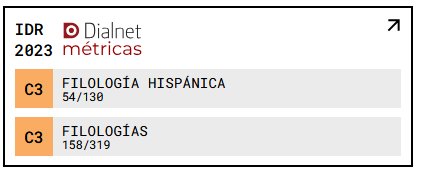Gabriel Celaya Or the Praxis of a Transgressive Poetics
Celaya's Transition from Existential Realism to The Orphic Dream
DOI:
https://doi.org/10.18172/cif.6423Keywords:
`Gabriel Celaya, transition, cosmic consciousness, Orphic poetryAbstract
Gabriel Celaya's poetic transition from his surrealist beginnings to his Orphic poetry is a clear example of constant subversion of the traditional poetic creed. In this contribution we focus on Celaya's ability to transfer his rebellious and dissenting personality to his verses, with the aim of demonstrating that the Basque poet’s human condition determines his conception of poetry. In this essay we identify the common thread running through all of this author's poetic periods: his desire to subvert the established order and to displace the human being from individual consciousness to the realm of cosmic consciousness.
Downloads
References
ASCUNCE ARRIETA, J. Á. (2012), “Introducción” a Trayectoria poética. Antología. Madrid, Castalia.
BETINBEGNA, D. (2024), “Unamuno, filología y posiciones sobre las lenguas. Postceptos americanos”. Interpretatio. 9, 1, pp. 24-42. DOI: https://doi.org/10.19130/iifl.irh.2024.1/29W00XS023
CELAYA, G. (1969), Lírica de cámara. Barcelona, Ediciones Saturno.
CELAYA, G. (1972), Inquisición de la poesía. Madrid, Taurus.
CELAYA, G. (1975), Últimos poemas. Madrid, Cátedra-
CELAYA, G. (1977), Poema 8, en Par de los levantes de la aurora, Poesías Completas I (1930-1939). Barcelona, Laia.
CELAYA, G. (1977), Bienaventurados, Poesías Completas I (1930-1939). Barcelona, Laia.
CELAYA, G. (1979), “Carta abierta a Víctoriano Crémer”, en Espadaña, 39, p. 29.
CELAYA, G. (1979), “El arte como lenguaje”, en Poesía y verdad (papeles para un proceso). Barcelona, Planeta, pp. 37-65.
CELAYA, G. (1979), “Introducción” a Poesía y verdad (papeles para un proceso), Barcelona, Planeta.
CELAYA, G. (1980), “Entrevista” por Rosa María Pereda, en El País/Libros, año II, 40, Madrid, 27.7.1980.
CELAYA, G. (1982), “Hacia una poesía órfica”, en Prólogo Penúltimos poemas. Barcelona, Seix Barral.
CELAYA, G. (1987), “Reflexiones sobre mi poesía”, Madrid, Universidad Autónoma de Madrid.
CELAYA, G, (2012), “Biografía”, en La higa de Arbigorriya, de Trayectoria poética, Antología. M. Ángel Ascunce (ed.), Madrid, Castalia.
CELAYA, G. (2012), “Allegro final”, en Trayectoria poética, Antología. M. Ángel Ascunce (ed.), Madrid, Castalia.
CELAYA, G. (2012), “Conciencia cósmica”, en Trayectoria poética, Antología. M. Ángel Ascunce (ed.), Madrid, Castalia.
CHICHARO CHAMORRO, A. (1985), Producción poética y trayectoria literaria de Gabriel Celaya, Granada, Universidad de Granada.
GASTÓN, A. (1981), “Prologo” a Gabriel Celaya, hoy (1968-1979. Madrid, Espasa-Calpe.
LASAGABASTER, J. M. (1992), “Gabriel Celaya o la poesía total”, en Zurgai, diciembre, pp. 13-14.
MARAÑA, F. (2001), “Gabriel Celaya, de la Poesía a la Historia”, en Pérgola, Bilbao, 148, abril, p. 5.
MARAÑA, F. (2011), Gabriel Celaya en el territorio del tiempo”, en Pérgola, Bilbao, 215, abril, p. 10.
MATEO LORENTE, M. (2023), La poesía temprana de Gabriel Celaya, Vitoria, Universidad del País Vasco, UPV/EHU.
MARTÍNEZ SARRIÓN, A. (1995), “La apertura al mundo órfico en la última poesía de Gabriel Celaya”, en F. Maraña, (ed.), Encuentro con Gabriel Celaya: noción y memoria poética (1911-1991), Leioa, Universidad del País Vasco.
MORALES LOMAS, F. (2012), “La poesía de Gabriel Celaya: surrealismo, realismo social y poesía órfica”, en Gibralfaro, 76. https://gibralfaro.uma.es/criticalit/pag_1806.htm
RICHTER, J. P. F. (1984), Teoría y estética, Madrid, Imprenta de Ramón Angulo.
RANCIÈRE, J. (2011), Política de la Literatura, Buenos Aires, Libros de Zorzal.
SCARANO, L. (2016); “Ethos testimonial y contra-canon (el caso de Gabriel Celaya), en Anclajes XV.1, pp. 35.61,
SCARANO, L. (2017), “Poesía de Historia. La conciencia expandida del último Celaya”, en Pasavento, vol. V.2: pp. 195-215. DOI: https://doi.org/10.37536/preh.2017.5.2.824
VIVAS. Á. (1984), Lo que faltaba de Gabriel Celaya, Madrid, Anjana Ediciones.
Downloads
Published
How to Cite
Issue
Section
License
Copyright (c) 2025 Víctor Cantero García

This work is licensed under a Creative Commons Attribution 4.0 International License.
The authors retain copyright of articles and authorize CIF the first publication. They are free to share and redistribute the article without obtaining permission from the publisher as long as they give appropriate credit to the editor and the journal.
Self-archiving is allowed too. In fact, it is recommendable to deposit a PDF version of the paper in academic and/or institutional repositories.
It is recommended to include the DOI number.
This journal is licensed under a Creative Commons Attribution 4.0 International License














